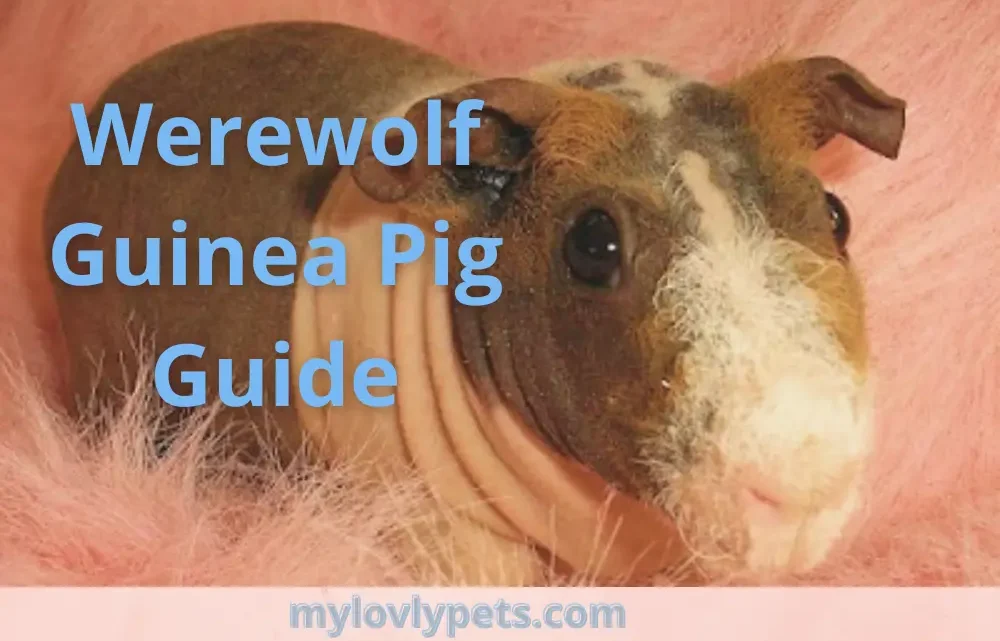
Werewolf Guinea Pig: The Ultimate Breed And Care Guide
If you previously believed that guinea pigs were the cutest thing ever, think again! Have you heard about the werewolf guinea pig? It’s an interesting new breed that differs from guinea pigs in appearance. They have the unique feature of being mostly devoid of hair, except for a few patches on their muzzles, feet, and legs.
I completely understand the reasoning behind their nickname “werewolf skinny pigs” due to their distinct appearance.
Thanks for stopping by our guide on werewolf guinea pigs.! We’ll talk about everything that’s important, like their housing, feeding, cleaning, and handling. Let’s get started and learn all there is to know about these unique and beautiful creatures.
What is Werewolf Guinea Pig?

“Werewolf” is a slang phrase that refers to skinny pigs with an unusually large amount of hair that extends up over the face, onto the neck, and onto the shoulders.
Werewolf skinny pigs with a lot of hair will have hair all the way down to their behinds. Werewolves usually grow and lose fur because of their hormone levels, especially hormones related to pregnancy.
The werewolf guinea pig breed was developed in the 1970s due to a genetic mutation. The werewolf guinea pig, a popular guinea pig, was created by breeding normal-haired guinea pigs with a hairless strain. Hairless guinea pigs come in two varieties: the skinny pig, which has small patches of fur, and the Baldwin, which is completely bald.
Werewolf guinea pigs are available in various colors including chocolate, golden, lilac, cinnamon, silver, and white. In addition, French Bulldogs come in various unique patterns, such as Dutch, brindle, and Himalayan.
What is The Difference Between a Werewolf Guinea Pig and a Skinny Pig?
| Characteristic | “Werewolf” Guinea Pigs | Skinny Pigs |
| Hairlessness | Have more hair than typical skinny pigs, especially over the face, neck, and shoulders. | Nearly hairless, with some fine hair on the muzzle, feet, legs, and occasionally a thin layer of shaggy hair on the back. |
| Coat Variability | Hair growth can vary based on hormonal factors, especially during pregnancy. | Maintain their hairless state consistently throughout their lives. |
| Hair Growth Fluctuations | Temporary increase in hair growth, often returning to a hairless state after hormonal influence subsides. | Hair density remains relatively constant, with no significant fluctuations based on hormones. |
| Skin Appearance | Skin may have varying amounts of hair, making them appear “werewolf-like” during periods of increased hair growth. | Smooth skin with some wrinkles around the legs and neck, giving them a somewhat wrinkled appearance. |
| Skin Tones and Patterns | Can exhibit various skin tones and patterns, similar to skinny pigs. | Also come in different skin tones and patterns, such as ‘Dutch,’ ‘Brindle,’ and ‘Himalayan.’ |
| Long-Term Coat Consistency | Temporary changes in coat density based on hormonal factors; return to a hairless state. | Consistently hairless throughout their lives. |
| Common Traits | Variable hair growth, linked to hormonal changes. | Nearly hairless with smooth skin. |
| Popularity | A variation of skinny pigs, less common than standard skinny pigs. | A recognized breed but still relatively new among pet owners, gaining popularity. |
| Key Feature | Variability in hair growth based on hormones, resembling a “werewolf” at times. | Known for their overall hairlessness and smooth skin. |
Werewolf Guinea Pig: Diet and Nutrition
When feeding Werewolf Guinea pigs, ensuring they receive a balanced diet is crucial. This includes hay, pellets, fresh vegetables, and fruits.
Guinea pigs cannot produce their vitamin C, so ensuring they receive enough through diet and supplements is essential. It’s important to note that werewolf guinea pigs have a higher metabolism and need more food than other guinea pig breeds.
Hey
Hay is an important part of a skinny pig’s food, and there should always be plenty of it around. It improves digestion and prevents irregular tooth growth. Hay is important for the overall health of these cute pets.
Pellets
When it comes to feeding your skinny pig, including pellets in their diet is essential. However, it is important to note that not all shots are suitable. When searching for food options, prioritize those rich in fiber and fortified with vitamin C. When selecting guinea pig food, opting for a variety that contains fortified essential vitamins and minerals, antioxidants, and prebiotics is crucial.
Avoid pellets that contain fillers like seeds, nuts, by-products of animals, or maize. To ensure the health and happiness of your guinea pig, it’s best to avoid foods that contain preservatives, artificial colors and flavors, and high sugar content.
Fruits and Vegetables
Fresh vegetables and leafy greens are essential for your skinny pig’s health. Leafy green vegetables including spinach, kale, dandelion greens, turnip greens, parsley, and romaine lettuce are great additions to a healthy diet.
In addition to clover, other plants that are rich in vital nutrients include chickweed, dandelions, and grass. Choose new growth and make sure the plants are pesticide-free while feeding them.
It’s important to keep in mind that fruits should only be included in the diet occasionally, generally once or twice a week. For fruits with a high level of sugar, this is especially true. You should consider apples, bananas, berries, pears, nectarines, papaya, and watermelon, among other fruits.
Werewolf Guinea Pigs: Health
When it comes to Werewolf Guinea Pigs, particularly the Skinnies breed, there’s good news – they don’t have any specific genetic defects or illnesses. Werewolf Guinea pigs are quite similar to their furry counterparts when it comes to their overall health.
The only noticeable difference is their lack of hair. These individuals maintain a regular level of activity and consume an average amount of food and water.
Although hairless, these werewolf guinea pigs typically have a similar weight to their furry counterparts. However, they can still contract the same illnesses as their long-haired counterparts.
Meeting temperature requirements is crucial for preventing susceptibility to illness. The well-being of your pets relies on a combination of factors, including their genetics, veterinary care, and the care you provide.
Werewolf Guinea Pig: Grooming
Grooming werewolf guinea pigs is crucial for their overall care. It is important to regularly clip nails, check teeth, and examine skin for any issues. A healthy diet is essential for maintaining soft and moisturized skin.
Care for Werewolf Guinea Pig Skin
It has been observed that Werewolf Guinea Pigs’ inherent pigmentation affects how their pigmentation changes in response to UV light. Due to their similar response to UV light, werewolf guinea pigs may likewise be at risk for sunburn and DNA damage from excessive UV light exposure.
The skin of hairless guinea pigs is constantly exposed, which can lead to dry skin if it is not well cared after. Werewolf Guinea Pigs need to be sheltered from excessive UV exposure because wild guinea pigs develop with fur so they can naturally prevent UV light harm. A bald guinea pig is more susceptible to sunburns and other skin damage from the sun’s harsh rays, just like bald people are.
The hairless bodies of werewolf guinea pigs make them more susceptible to things than they would have been with fur. Studies have shown that Werewolf Guinea Pigs develop allergy reactions similar to those of humans to known skin irritants.
In many aspects, guinea pig skin should be handled with the same care as human skin. For skinny pigs with dry skin, coconut oil can be an option. Always get the opinion of a qualified veterinarian before making any changes to the health routine of your Werewolf Guinea Pig.
Creating an Environment
Creating a cozy environment is critical to becoming a pro at handling your skinny pig. When introducing your pet to a new environment, giving them ample time to acclimate is crucial. Remember to speak to them gently, ensuring a calm and comforting atmosphere. It’s important to create a comfortable and relaxed environment when it comes to cuddling. Avoid anything that might scare your cuddle buddy, as it can damage your cozy sessions together.
Are Werewolf Guinea Pigs Right for You?
Consider adopting a werewolf guinea pig. These adorable creatures are just as affectionate as their furry counterparts. However, what makes them truly unique is their mostly bald appearance, setting them apart from the crowd.

If you’re considering getting a werewolf guinea pig, be ready to shell out a little extra cash. These adorable creatures are in high demand and can be pricier due to their unique breeding challenges and current popularity.
In addition, these animals need extra attention because they struggle with regulating their body temperature and are more prone to health problems. Investing in a pet is worth it, as you’ll be rewarded with a delightful and friendly companion who always brightens your day.
How Much are Werewolf Guinea Pigs?
Once shunned, Werewolf Guinea Pigs have risen from outcasts to become the trendsetters of the guinea pig world. As their popularity has skyrocketed, so has their price. If you’re considering adopting one of these trendy pets, be ready to spend between $100 and $200.
If your heart is set on a particular color, be prepared to spend even more money. When it comes to Werewolf Guinea Pigs, remember that they thrive in social settings. So, it’s worth considering getting a pair or more! If you want to save money, consider pairing them with a regular guinea pig. It can be a budget-friendly option that still brings joy.
How to Take Care of Werewolf Guinea Pigs?
Taking care of Werewolf Guinea Pigs means making sure their home, tank, and setup are just right.
To make sure these special creatures are happy, we need to give them a big tank to live in. Each Werewolf guinea pig should have at least 7.5 square feet of space. When making a home for your pet, remember that it’s more important for the cage to be wide than tall. This is because they love to explore all around them, going left and right. You should put lots of toys and different things to play with.
Werewolf Guinea Pigs need good bedding to stay warm. They like to dig into it when they get cold. When you pick bedding for your pets, it’s best to choose paper shavings or similar stuff. It’s important to stay away from cedar and pine bedding because they have harmful chemicals in them.
It’s extremely important to keep guinea pigs at the right temperature because they have a hard time controlling their body temperature. To make sure your pet is comfy, keep their cage warm between 65°F and 75°F. Don’t put their cage near things that make them too hot or too cold, like vents, fireplaces, or the sun.
Guinea pigs don’t need special lights. Because they are not nocturnal, it is essential that you provide them access to natural sunshine so that they may maintain their health.
In order to properly care for Werewolf Guinea Pigs, you need to provide an environment that is stimulating, large, and the ideal temperature. You need also to use the appropriate bedding. If you follow these rules, your pets will be happy and healthy.
References:


